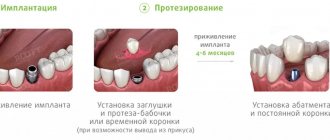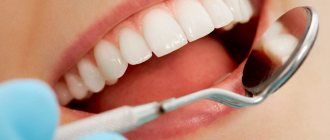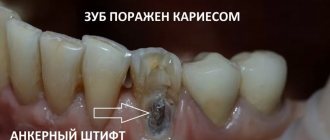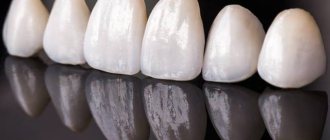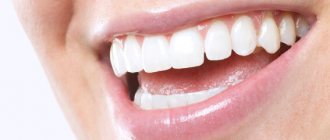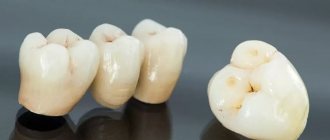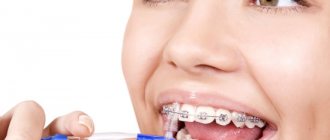Bridges - adhesive, ceramic, metal-ceramic, solid, install on implants and inlays at a competitive price.
It often happens that people lose teeth at a young age. Some become victims of bad genetics, others get into traffic accidents and receive serious injuries, others are exposed to infectious and inflammatory processes, etc. However, regardless of what reason led to the loss of teeth, this causes discomfort during communication and chewing food, and also leads to disturbances in the functioning of the gastrointestinal tract.
Fortunately, modern dentistry does not stand still, and prosthetics with bridges can solve the problem of the lack of several natural crowns in a row. Such structures are non-removable and are firmly attached to nearby teeth or implants. Also, today you can find dental bridges, for the installation of which metal/fiberglass beams or inlays are used.
If a bridge is placed on the original crowns, the number of missing units should not exceed 2 pieces. In case of loss of three or more teeth, it is advisable to use implants or resort to removable prosthetics.
The Elident clinic employs competent doctors who will not only professionally install a bridge, but also advise you on any questions regarding the installation of such dental structures. Having deep knowledge in the field of dental restoration, having impressive experience in the manufacture of various types of structures and perfect skills in working with modern materials, we are ready to guarantee reliable and long-term treatment results. That is, regardless of whether you need to install a metal-ceramic or ceramic bridge, all work will be carried out at a high level, in the shortest possible time and at affordable prices.
From this article you will learn what dental bridges are, you will be able to get acquainted with the algorithm for their installation and find out which types of such products are considered the best. In addition, we will talk about existing prices, describe some of the “cons” of these dental structures and provide information about the features of caring for them. These and other points will be discussed in this work.
Free consultation
Our specialists will conduct a free consultation and select the best treatment option for you.
Sign up now! Online registration
+7 (495) 649-41-19
Content
1 Indications for bridges and limitations for their use
2 Features of installing a fixed bridge 2.1 Method of grinding dental units for a future prosthesis
2.2 Preparation of supporting units for installation of prostheses
3 Bridges, before and after photos:
4 Which bridge structures should be preferred?
5 Solid structures
6 Metal-ceramic products: characteristic features
7 Ceramic fixed bridge: features 7.1 Some “cons” of zirconium bridges
8 What are the features of adhesive bridges?
9 Use of inlays for fastening dentures
10 Bridge prosthesis on implants
11 Basic rules of care
12 Price for a bridge
Indications for bridges and limitations for their use
As stated earlier, dental bridges can correct the defect associated with the deficiency of one or two missing units. Also, designs of this type are used in cases where the problem of the lack of natural crowns cannot be solved in any other way.
The processes that prohibit the use of bridge-like fixed dentures include:
- Incorrect location of dental units in the oral cavity;
- The presence of bruxism;
- Pathology in which there is intense loss of enamel;
- Diseases of the oral cavity in the acute phase;
- Osteoporosis;
- Acute inflammatory processes in the area of periodontal tissue;
- Inadequate oral care.
Since there are different types of bridges, differing in the method of fixation or the material used, you should first consult with your doctor regarding their choice.
We employ experienced and polite specialists who take into account both individual factors and the financial capabilities of each patient.
Stages of installing a dental bridge
- Examination and diagnosis.
This stage is very important. This allows you to eliminate any restrictions and determine the type of bridge the patient needs. The doctor will examine the entire mouth. He will direct you to a targeted x-ray if it is a specific tooth, or rather a CT scan (images that are more precise and less radial) to see the teeth in all projections. You may also need a panoramic x-ray to see the entire situation. These technologies are available at the Implantmaster clinic. Our specialists have the ability to model a new smile in 3D. This way, the patient will see the results that can be achieved. Additional tests may be prescribed. Based on the data obtained, a further treatment plan is formed.
- Preparing the oral cavity for prosthetics.
The design will last a long time if the patient does not have untreated teeth, gum inflammation, tartar and soft plaque. Preliminary treatment of caries and cleaning of the oral cavity is carried out, during which all dental deposits are qualitatively removed.
- Prepare your teeth before placing a bridge.
The selected teeth are ground under the holder and, if necessary, wiped down. Depulpation is a procedure for removing the neurovascular bundle from a tooth. Why is this necessary before installing a bridge? During tooth rotation, overheating of the pulp is possible, causing the development of pulpitis. In this regard, the pulp is sometimes pre-squeezed.
- Receiving a fingerprint (scanning).
In our clinic, ground down teeth are scanned instead of taking impressions. The 3Shape trios scanner scans everything in the mouth, individual teeth and bridge spaces. The workflow becomes more efficient and comfortable for patients. It makes it easy to take full-color 3D impressions for subsequent creation of prosthetics. When the bridge is ready, the patient is asked to try it on.
- Fitting
If during fitting no manufacturing inaccuracies are found: it fits tightly, fits well over the bite and the patient likes the appearance of the prosthesis, the bridge in the oral cavity is installed with special dental cement. After this, the doctor conducts a detailed consultation and gives recommendations on how to properly care for the oral cavity and the product.
Features of installing a fixed bridge
The installation process of the above structure is as follows. The role of supporting elements is played by the teeth located on both sides of the lost unit. If there are no two natural crowns in a row in a row, then 3 units will act as supports (one on one side of the lost tooth, and two on the opposite side).
Regardless of whether the bridge will be fixed to the front teeth or installed on the chewing teeth, preparation of the supporting crowns is a prerequisite. Turning parameters may vary depending on the type of prosthesis being installed. If you plan to wear a metal-ceramic bridge, it is necessary to prepare the supports by 1.5 mm on the lateral part, and by 2-2.5 mm on the chewing side. If a ceramic bridge is installed, turning is carried out by 1 and 1.5 mm, respectively. It should be taken into account that the duration of the operational period is influenced by the preserved surface of the dental tissues located under the structure: the larger it is, the longer the service life of the bridge will be.
Method of grinding dental units for a future prosthesis
It should be noted that tooth preparation in close proximity to the gum tissue is carried out in such a way that a kind of ledge is formed on the stump. In turn, the ledge must be formed in such a way that the crown fits as closely as possible to the neck of the tooth. This will prevent infection from penetrating under the prosthesis, prevent the destruction of dental tissues and significantly extend the service life of the structure.
The concept of a composite structure
A prosthesis for replacing several teeth of a standard type for installation with existing inclination of adjacent teeth is not used. It will not be possible to eliminate the non-parallel position of the supporting teeth by grinding. It becomes possible to touch not only the dentin, but also to open the pulp channels.
The problem can be solved with composite bridge systems that have articulation. This connection allows you to install the prosthesis on non-parallel units of the dentition. These types of structures are made from dental metal.
It contains a similar version of the intermediate part, which looks like an occlusal pad over the place of lost teeth. Also in the bridge-like composite overlays there are fastenings of various types. There are also components of the mechanism connecting the parts of the bridge.
Attending doctors at the Elident clinic
Mlodik Boris Naumovich
Dental surgeon, implantologist, orthopedist
Clinical experience : 26 years
Vakhrushev Alexander Viktorovich
Dental surgeon, implantologist, orthopedist
Clinical experience : 25 years
Preparation of supporting units for installation of prostheses
In most cases, natural crowns, on which a permanent bridge will be fixed in the future, are subject to pulp removal. This is due to the high probability of injury to the neurovascular bundle during turning. However, when a metal-ceramic structure is put on, there is no need to remove the nerve in large dental units, since they have denser walls.
You can also keep your natural teeth alive if you install a ceramic bridge. The ability to preserve the nerve is considered necessary, since this has a positive effect on the strength and durability of natural units.
When it is planned to install a bridge, the cost of depulpation and subsequent filling is determined by the number of root canals, and can range from 2,500 to 5,000 rubles, respectively.
If, after the loss of a tooth, healthy, living crowns remain nearby, the possibility of grinding them down for a future bridge is considered undesirable. The same goes for nearby units that previously had small seals installed. In such situations, it is advisable to install one implant: its cost will cost you less than installing a bridge.
It is recommended to install a bridge in Moscow only when the teeth located on the border with the missing one were previously filled by 50% or were subjected to depulpation.
Advantages and disadvantages
| pros | Minuses |
| Homogeneous design, lack of solder, which increases the strength of the product. Unlike other prostheses, solid ones almost never break, because there are no weak joints | Low aesthetics |
| High strength and durability | The cost is higher than a cast prosthesis |
| Tight fit to the tooth, which prevents food particles from getting under the crown, and this prevents secondary caries and destruction of enamel under the prosthesis, and also reduces the likelihood of damage to the structure | Great thermal conductivity |
| High functional efficiency due to precise modeling of support elements and intermediate parts | Risk of discomfort when eating hot food |
| No darkening factor in the structure in the soldering area | Cannot be determined in case of metal allergy |
| Wax can be used to thicken the walls of an orthopedic product. | The need to grind healthy crowns, which over time leads to their destruction due to malnutrition |
| The one-piece design is better tolerated by patients, the risk of prosthetic stomatitis is reduced | High load on abutment teeth can cause them to become loose |
Which bridge structures are best?
When it is planned to fix a bridge prosthesis on the front teeth, its price leaves much to be desired, since we are talking, first of all, about aesthetics. To produce artificial teeth that replicate natural teeth in transparency and shade, it is necessary to use high-quality material – zirconium dioxide.
In addition, the specialist’s work is greatly complicated by situations caused by excessive exposure of the patient’s gums when smiling, as well as those associated with a significant degree of transparency of the enamel. In this case, the question of how much a bridge costs takes a back seat, since the primary goal is to achieve impeccable aesthetic characteristics.
However, if a bridge is placed over chewing teeth, then functionality becomes a priority.
Next, we will consider the following types of bridges:
- Metal-ceramic structures;
- Adhesive bridge prosthesis;
- Zirconium dioxide products;
- Solid-cast bridges.
What material to choose a bridge from?
Metal-ceramic bridges
The next stage of construction is metal-ceramic bridges. This type of “bridge” has made it possible to significantly expand the scope of application of bridges in solid castings by covering them with ceramics. The statement “cover them with ceramics” is not entirely true, since this design of the prosthesis implies not only an all-metal coating, but also a modification of the design, due to which the metal-ceramic bridge consists of a metal frame and a ceramic coating. This led to its advantages and disadvantages.
Advantages:
- Significant improvement in aesthetic performance compared to permanent bridges
- Expanding the scope of application, which implies the possibility of using such a design when restoring defects in the anterior group of teeth
- The almost complete correspondence of this type of prosthesis to the natural appearance of the teeth allows the patient to quickly psychologically adapt to them, which largely restores the level of quality of life.
Flaws:
- The absence of a chemical bond between the metal structure and the ceramic veneer suggests the possibility of the ceramic cracking
- The presence of metal in the oral cavity can cause allergic reactions, galvanic effects and negative effects of metal on dental tissue and staining.
The aesthetics of metal-ceramic prostheses is relative. Compared to solid bridges, the design of the prosthesis is much wider, however, the passage of metal through ceramic masses and designs with a “garland” do not allow comparing the aesthetic qualities of such a prosthesis with an all-ceramic one.
However, it is important to note that replacing the cobalt-chromium alloy more commonly used in metal frames with noble high-gold alloys provides superior aesthetics.
The natural color of gold, which shines through the ceramic masses, allows you to recreate the natural color of your teeth. Together with the advantages of metal-ceramic prostheses and the absence of the disadvantages of all-ceramic bridges, this design occupies a leading position in terms of aesthetics and functionality.
All-ceramic bridges
All-ceramic bridges have firmly established themselves as one of the most aesthetically pleasing and functional designs. This explains that manufacturing companies often improve methods for making just such prostheses. Computer modeling and milling are increasingly being introduced into everyday dental practice. The development of these technologies makes it possible to increasingly reduce the time required to build bridges, right down to visiting the dentist.
Methods of layering ceramic masses with restoration of the smallest dental structures make it possible to create prostheses that are as close as possible to natural teeth. Thanks to the strength characteristics of modern ceramic materials, metal-free bridges have excellent functional characteristics, but this also has a downside.
While metal-ceramic implants have a certain degree of flexibility, all-ceramic implants have a much lower elastic modulus. For this reason, loads that lead to chipping of ceramics in metal-ceramic structures can lead to rupture of metal-free “bridges” with the need for their complete replacement, and ceramic fragments can be repaired in a clinical setting.
And yet, despite this drawback, all-ceramic bridge designs are the most progressive and will be the vector for the development of materials and production technologies.
Adhesive bridges
An alternative to the work of a prosthodontist is increasingly offering adhesive bridges, which can also be made by appointment with a dentist, if he has sufficient skills. Adhesive bridges are made of composite materials using fiberglass tape, similar to the construction of a bridge, or using conventional orthodontic wire.
This combination allows dentures to be made directly in the patient’s mouth in one visit with minimal preparation of the supporting teeth, which significantly reduces the financial component of the problem.
However, the functional qualities of such prostheses are not always satisfactory, and the aesthetic qualities of composite materials often cannot compete with ceramic materials due to the impeccable polishing and natural shine of the latter. But with the correct choice of such a treatment method for the restoration of short-length defects in the dentition in the lateral areas extending beyond the aesthetic zone, in areas with less functional load, this design of bridge prostheses turns out to be extremely logical and convenient: the dentures have a long service life, providing patients with a beautiful appearance view.
Solid structures
Solid-cast bridges are a single structure made using injection molding technology. The creation of such a product is based on the use of cobalt-chrome alloy. Depending on the patient’s preferences, a cast bridge can be presented in the following options:
- Using gold-like plating;
- Without the use of “gold” plating;
- With plastic or ceramic coating.
An important feature of such bridge structures is their precise fit to the supporting crowns, which prevents the penetration of food debris and the appearance of deposits under them. Such products are characterized by increased strength and a long service life. Their service life can reach 10 years, without the need for significant preparation of the supporting units.
The production process of cast bridges is considered quite simple and does not require the use of innovative techniques, but the quality of the above structures is impressive.
The only drawback of such products is their low aesthetics, which allows them to be fixed only to dental units located in the chewing area.
Metal-ceramic products: characteristic features
A metal-ceramic bridge is a complex dental structure that includes a metal base and an outer ceramic layer. In this case, the prosthesis frame can be made of cobalt-nickel or cobalt-chrome alloy, and can also contain precious metals.
Currently, designs based on the use of gold alloys are especially in demand. This allows you to get the most natural shade of the crowns and use them to restore lost units in the frontal zone. In this case, the frame can have a thickness of approximately 0.5 mm.
Advantages of metal-ceramic prostheses:
- Allowed for use in the frontal zone;
- The metal bridge has a solid base, which contributes to the high reliability of the product and ensures a long service life;
- The ceramic layer is resistant to abrasion;
- Can be repaired if cracks or chips occur.
It should be remembered that before fixing a metal-ceramic bridge, the supporting crowns are subjected to pulp removal and turning.
Ceramic fixed bridge: features
As you know, a ceramic bridge is considered the most expensive: its price is determined by the use of a material characterized by ideal aesthetic qualities and increased strength. We are talking about zirconium dioxide.
At the same time, in the process of creating these structures, a milling machine with modern software is used. However, not the entire bridge is milled, but only the base, made of zirconium dioxide, which is subsequently lined with porcelain. Thanks to this technology, the aesthetic parameters of the structure are significantly improved.
Due to the extreme strength indicators (more than 900 MPa), a metal-free prosthesis can have any length, which is not possible when using other types of ceramics. The following is an algorithm for producing such bridges.
So, the process of manufacturing a metal-free structure includes the following steps:
- Initially, the doctor prepares the supporting crowns, which involves removing the nerves and further preparation in order to ensure the most precise fit of the prosthesis;
- Next, the product is reproduced in three-dimensional format, during which special software and the resulting scan of the jaw are used;
- The frame of the product is produced;
- After this, the frame made on the basis of a three-dimensional model is fired, which makes it possible to obtain the necessary characteristics of wear resistance and strength;
- Ceramic mass is applied to the base layer by layer;
- The structure is being painted.
Since zirconium material has the same light transmittance as natural enamel, bridges made from it perfectly recreate the lost units in the frontal zone.
In addition, ceramic products are distinguished by a tight fit to the supporting crowns, which prevents the penetration of infection under them. The ability to maintain a natural shine for a long time is also one of the “advantages” of metal-free dentures.
Some "cons" of zirconium bridges
When using ceramic bridges for prosthetics, the following disadvantages may occur:
- Overpriced;
- High risk of chipping. Despite the fact that zirconium material has extreme strength, the outer porcelain layer is quite fragile and there is an increased likelihood of chipping. According to statistics, such defects occur in approximately 10% of patients within 6 years from the date of installation of ceramic products;
- Some aesthetic inconsistency. If ordinary zirconium blocks are used, they have a milky tint and do not provide the translucency inherent in natural crowns. However, nowadays you can find more expensive and natural-looking zirconium material that allows you to achieve ideal aesthetics, for example, Katana® UTML (Japan) and Prettau® Anterior (Germany).
Get a consultation
We will answer all your questions before visiting the clinic!
+7
Online registration
Metal-ceramic dental bridge
Ceramic metal inside has a cast metal frame, covered on the outside with porcelain mass. Unlike ceramics, metal is completely opaque, and therefore only opaque porcelain can be used to cover it. Thus, metal-ceramic bridges and crowns lack the light refraction of natural enamel, and aesthetically they do not look as good as metal-free ceramics. Aesthetic problems with metal-ceramic prosthetics will be minimized if the entire smile area (from canine to canine) is taken into account for the design. This way, when speaking, only the same “teeth” will be visible. However, the crowns become noticeable and will stand out against the background of your own teeth if the prosthesis is installed on only 3-4 teeth.
The cost of 1 unit of metal ceramics varies on average from 15 to 45 thousand rubles. Why is there such a difference? Metal ceramics can be “standard” and “increased aesthetics”. Standard metal-ceramics - 15,000 rubles for 1 crown and is made from a regular cobalt-chrome alloy.
When it comes to prosthetics of the frontal group of teeth, only expensive ceramic mass is not enough to achieve high aesthetics. With standard metal-ceramics, the lower edge of the metal frame, located slightly below the gum level, is not insulated with ceramics. It is always in contact with the gum, which leads to a gradual change in color. Also, its level drops and the dark metal edge of the crowns is exposed. If you are going to cover chewing teeth, this may not be important, but for the frontal group of teeth these problems are critical.
To solve the problem of blueness and receding gums, there are designs with “shoulder mass”. Their lower edge of the metal frame is covered with ceramic mass on top. 1 unit of metal ceramics with shoulder mass will amount to an additional 5,000 rubles to the total cost.
It is worth considering that the price of a metal-ceramic dental bridge includes some other costs. For example, temporary plastic crowns - about 2 thousand rubles per unit, also, preparing teeth for prosthetics - another 2,500 rubles per tooth. To restore 1 missing front tooth, it is more profitable to install an implant, which even with a ceramic crown will cost about 65 thousand rubles.
What are the features of adhesive bridges?
An adhesive bridge has a more gentle method of attachment to the supporting crowns. When using this design, there is no need for total preparation of the natural units necessary for its fixation.
Below we describe cases in which it is better to use an adhesive bridge:
- Minor defects in dental units located in the chewing and frontal zones;
- In the presence of inflammatory processes in the area of periodontal tissue;
- If standard methods of restoring teeth are unacceptable, due to a particular disease in the patient;
- Ideal for people who have had a heart attack;
- Patients who prefer a gentle method of prosthetics.
To fix the above bridge, only one visit to a specialist is required. If the bridge structure is planned to be made in a laboratory, you will have to visit the doctor again.
3 methods of fixing an adhesive prosthesis:
1. Using a composite adhesive
In this case, the specialist glues strips of fiberglass or plastic to the inner surface of the teeth. The main purpose of these elastic plates is to connect artificial crowns with natural ones. This method is not used for units located in the chewing zone;
2. Beam technique
To do this, small recesses are made in the supporting crowns, into which a special wire beam is subsequently attached. In this case, the priority option would be for the patient to have dental units with impressive fillings, which makes it possible to obtain ready-made recesses for the beam. But this method has one significant “minus” - an increased likelihood of pulpitis in the abutment crowns.
3. Splinting method
This method is based on the use of a special tape made of fiberglass material, for fixation of which the dentist drills a small cavity in the support units.
The advantages of such designs include:
- Possibility of instant removal of the bridge from the oral cavity if necessary;
- Good aesthetics, since the prosthesis does not contain any metal components;
- There is no need to remove the nerve;
- Easily repairable in case of fracture;
- It is possible to maintain some mobility of the supporting units, which is achieved due to the presence of an elastic composite material.
Indications and contraindications
An indication for installation may be the absence of one or more incisors or molars in a row. It is important to have supporting teeth that can withstand the increased pressure of chewing. Bridges are recommended for patients who, for one reason or another, are not eligible for implantation (medical conditions, lack of funds).
Bridges are contraindicated for patients suffering from bruxism and inflammatory diseases of the oral cavity. Prosthetics are not recommended for pregnant women and persons with malocclusion. Please note that if oral hygiene is poor, the dentist has the right to refuse prosthetics to the patient.
The use of inlays for attaching prostheses
To fix bridges, it is allowed to use special inlays made of ceramic or metal material. In this case, there is no need for total grinding of the supporting crowns: it is enough to make a small ledge on the chewing side of the dental unit.
The installation of such products is recommended only to reproduce 1 lost unit in the presence of healthy nearby crowns. In addition, due to the insufficient stability of structures on inlays, sometimes it is necessary to fix the crown at one edge.
Our clinics
Clinic "Elident" on Varshavskaya
Varshavskoe highway, 75, bldg. 1, Moscow 117556
- Varshavskaya (500 m, closed until 2021)
- Nakhimovsky Prospekt (1,300 m)
Mon-Sat : 09:00-21:00; Sun : 09:00-19:00.
Online registration
+7 (495) 649-41-19
Elident Clinic in Annino
Varshavskoe highway, 154, building 1, Moscow 117405
- Annino (500 m)
- Academician Yangelya (700 m)
Mon-Sat : 09:00-21:00; Sun : 09:00-19:00.
Online registration
+7 (495) 649-41-19
Bridge prosthesis on implants
A bridge on implants is considered one of the most durable and reliable products used in prosthetics. A prerequisite for its fixation is the implantation of implants.
The installation process of this bridge is also carried out in several stages. These include:
- Preparation period: the specialist directs the patient for appropriate laboratory tests, assesses the condition of his oral cavity, takes an x-ray, studies possible limitations for prosthetics, carries out the necessary therapeutic measures, selects the appropriate type of prosthesis;
- If necessary, osteoplasty surgery is performed;
- The implants are being implanted. Depending on the number of lost teeth and the length of the bridge, 2-4 support screws are used. As a rule, the process of implantation itself is carried out quickly, and the engraftment period can reach 4-6 months. During this period, the specialist installs a temporary plastic bridge;
- After completion of the above period, special connecting elements (abutments) are put on the supporting feints;
- Next, the dentist makes impressions, which are used as a basis for the further production of the bridge structure;
- At the final stage, the bridge is fixed using a special cement composition.
What to do if the dental bridge starts to loosen?
When you feel that the previously fixed structure has become loose, you should immediately contact the clinic!
There are a couple of reasons why this situation occurs:
- Breakage of one or two teeth used as support.
- Violation of the structure of the material used for final fixation.
You won't be able to determine the cause yourself. This requires specialized diagnostics. When you get an appointment, the doctor will examine the structure. He will order an x-ray to clearly determine the condition of the supporting teeth and their roots, in order to understand exactly why the bridge does not hold firmly in the mouth.
Regardless of the reasons, in order to better consolidate the dental bridge, it will need to be removed. There is no other way to secure it back into the oral cavity. We recommend not to listen to “online advice” on gluing dentures with glue and other means. Because of this, negative consequences may appear - severe allergies, inflammation and damage to the mucous membrane of the gums, tongue, palate, cheeks.
Basic rules of care
Careful care of the prosthesis is a guarantee of its long-term operation. At the same time, it is important to pay attention to hygiene: it is necessary to clean the bridge, as well as the places where it adjoins the supporting dental units, at least 1-2 times a day. This will avoid the accumulation of food debris in this area and the development of infectious processes.
Experts recommend using gentle products that do not contain solid particles to eliminate the possibility of damage to the prosthesis. Also an important condition for the durability of the product is regular visits to a specialist for preventive purposes.
Price for a bridge
When considering a bridge on implants or other supporting elements, the price can be determined based on the materials used, the mounting option, the length of the prosthesis and other factors. It should be taken into account that in the production of a bridge structure at least 3 artificial crowns are used, which is why the cost must be increased three or more times.
So, for example, if you need to install an adhesive bridge to restore one lost crown, get ready to pay from 13,000 rubles. In turn, the price of a solid cast product starts from 10,000 rubles, and the cost of a ceramic structure can reach 60-70,000 rubles.
| Service | Price, ₽. |
| Consultation with an orthopedist | for free |
| Orthopantomogram - panoramic image of teeth | 950 |
| Ceramic crown Dutseram plus (Germany) | 20 500 |
| Ceramic crown made of zirconium dioxide | 35 000 25 000 |
| Empress crown | 19 000 |
| Ceramic crown made of zirconium dioxide on an implant | 35 000 |
| Temporary plastic crown/wedge. | 2300/1500 |
| Taking an impression from alginate mass | 400 |
| Diagnostic plaster model | 400 |
| Taking a double impression | 800 |
| Cementing inlays and crowns using Fuji cement | 700 |
| Cementing inlays and crowns using Fuji+ cement | 800 |
| Temporary cementation of one crown | 400 |
| Removing one crown with stamped sawing | 500 |
| Removing one crown with sawing the cast | 1 000 |
| Removing one crown with sawing MK | 800 |
Article expert (author):
E.max ceramic dental bridge –
If you are planning prosthetics on your front teeth, then a dental bridge made from IPS E.max ceramics is the best option in terms of aesthetics (even compared to bridges made from Multi-layer zirconium dioxide).
The “Emax” material refers to glass ceramics, because this material consists of 70% lithium disilicate crystals. Due to the fact that the E.max glass matrix is as similar in structure and transparency as possible to natural tooth enamel, crowns, veneers and bridges made from this material can be made completely invisible against the background of neighboring teeth. Clinical case No. 1 – before and after photos
Clinical case No. 2 – before and after photos
E.max glass ceramics is practically the only material that allows achieving good aesthetics in patients with a high level of transparency of tooth enamel (if the transparency coefficient is low, then good aesthetics can be achieved with zirconium dioxide). E.max crowns require less grinding of the supporting teeth, which increases their service life. And besides, the use of this material practically eliminates the occurrence of ceramic chips.
Important points - E.max ceramics are available in several versions, but for the manufacture of bridges it is best to use “IPS E.max PRESS”. Bridges are made from this material by pressing under conditions of very high temperature and pressure, making the finished structure very strong (about 400 MPa). However, there are several limitations for E.max bridges...
Firstly, you can make bridges from E.max with a length of no more than 3 units, i.e. They can only restore a single missing tooth. Secondly, their safety margin is sufficient to restore mainly only the anterior group of teeth (the distant abutment tooth should be no further than the 5th tooth inclusive). Therefore, if you need to restore the chewing group of teeth, then a priori the choice falls on bridges made of zirconium dioxide or metal ceramics.
Conclusion: The E.max glass-ceramic bridge is the best option if you require a 3-unit bridge in the anterior area and if you have the highest esthetic requirements. Considering that 1 crown made of E.max PRESS material will cost in Moscow in 2022 - from 26,000 rubles, then the cost of a bridge of 3 units will already be about 72,000 rubles. In the regions, the price for 1 unit may be slightly less (from 20,000 rubles). And don’t be confused by the fact that E.max is cheaper than bridges made of zirconium dioxide - it’s just that very expensive equipment is used in the manufacture of the latter, which affects the cost.
